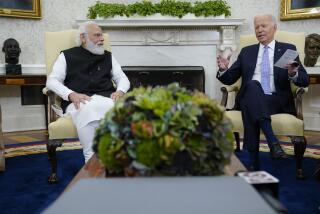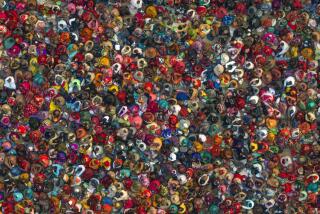India Races to Keep Up With Itself
- Share via
NEW DELHI — Early in my time in India, I rode beside N.T. Rama Rao atop the Chariot of Divine Enlightenment.
At the time I did not feel particularly enlightened, and certainly not divine--especially after a banana thrown by one of the politician’s adoring fans hit me square in the chest and nearly knocked me off. Mostly I felt foolish.
Four years later, however, as I complete my tour here and prepare to leave, I recall the strange ride as one of the most telling moments of the months in India, one that spoke both of the beauty of the great Indian democracy and of the dangers sapping it.
For as Rama Rao, chariot and all, affirmed the existence of a vital and vigorous political system, so the presence of a huge crowd of supporters--mostly young men without jobs or the prospects of jobs--called to mind India’s biggest challenge: its ever-growing population.
I lived through the bloody anti-Sikh riots that followed Indira Gandhi’s assassination in October, 1984. The screams of “ Bacchao lo “--”Help me!” in the Hindustani language--that filled those dark nights are impossible to forget.
I witnessed the industrial horror that took place at the American-owned pesticide plant in Bhopal when deadly methyl isocyanate gas spilled into nearby slums, killing more than 2,800 people.
I watched India flex military muscle in Sri Lanka, exercising its version of gunboat diplomacy to intervene in the island nation’s ethnic conflict between Tamil separatists and the Sinhalese majority.
And I saw Prime Minister Rajiv Gandhi apply radical economic reforms in an attempt to stimulate a system long-dominated by heavy state industries and licensed monopolies.
But at the end, that political rally jumped first to mind. The Chariot of Divine Enlightenment is what Rama Rao, a south Indian political leader and former Telegu language movie star, called a 1942 Chevrolet truck. He had customized it for campaign appearances such as the one, four years ago, against the late Indian Prime Minister Indira Gandhi.
Inside the truck was a ladder that allowed Rama Rao to ascend god-like through an opening in the roof. At the rally, he invited me up with him. Several doctors periodically checked Rama Rao, a first-class hypochondriac, for blood pressure and other vital signs. Other aides kept him from being clotheslined by electric wires, something the Hindu gods he used to portray in the movies never had to worry about.
The event was good theater and, as it turned out later, good politics. Rama Rao overcame allies of Mrs. Gandhi to be reinstalled as leader of Andhra Pradesh, a state with a population equal to that of France; he remains in office today. His victory was a fairly typical example of India’s lively democracy, the model and envy of the Third World. But there was something else about it that gnawed at me for the rest of my time in India.
Below the divine charioteers, in the dusty streets of Sri Kalahasti, a medium-sized city in Andhra Pradesh, a huge crowd surged against the truck. A sea of young faces--mostly men in their late teens and early 20s--gathered for the political event.
The faces shone with energy and intelligence and hope. But the surrounding town and the barren terrain--stripped of vegetation by chronic overgrazing and human foraging for firewood, devoid of industry and trade--promised a future of desolation and despair.
The majority of the young men were unemployed. There was no work for them in this area unless they somehow landed a job in the nearby city of Tirupathi, where a modest tourist industry serves the thousands of pilgrims who visit a famous temple at the top of the hill.
Their main chance was to go eventually, like thousands before them, to the big cities--Hyderabad, Madras, Bangalore and Bombay--for work. Population experts have predicted that by the turn of the century Bombay and Madras will have been swollen with similar migrants to become two of the largest cities in the world, each with more than 20 million residents. Hyderabad and Bangalore are expected to reach 10 million. So those young men at the rally in Andhra Pradesh represented something unfulfilled and perhaps unfulfillable about India and its beloved democracy.
How can terribly poor India, struggling valiantly in a Malthusian quagmire of increasing population and diminishing resources, possibly manage to answer the hope in the eyes of those young men? What will happen to them and their sisters? How much longer can the world’s largest democracy remain democratic?
In the Third World, India inspires the classic question: Is the glass half full or half empty? Almost alone among the poorer nations, it has clung fiercely to a democratic system. With the exception of the infamous emergency period of the late 1970s, when civil rights were temporarily suspended by the late Indira Gandhi, it has kept intact its basic freedoms and democratic institutions.
The country is a crazy-quilt of religions, races and languages. Recent international press coverage has spotlighted the conflicts between Hindus and Sikhs in Punjab and the occasional flare-ups between Hindus and Muslims in other parts of the country. But at its heart, India is a remarkably tolerant land that relishes its eccentricities and excesses.
India enjoys perhaps the freest and liveliest press in the Third World. And while other, richer, countries have fallen hopelessly in debt to the West, India has kept its credit strong. After several close calls with famine, it has overcome great odds to become self-sufficient in food. Its universities produce more qualified engineers and scientists than anywhere outside the United States and the Soviet Union.
Since India gained independence from the British in 1947, the value of its industrial production has jumped from less than $600 million to more than $46 billion. For the first time in its history, India enjoys surpluses in cement and synthetic textiles. It produces more than seven times as much steel as it did in 1950.
For its growing middle class, an ever-spreading array of products ranging from gel toothpastes to Barbie dolls are now available. Health has improved vastly: the average life expectancy has vaulted from 32 years in 1947 to 57 years today.
Yet on another front India seems doomed to lose a terrible race with itself. Overpopulation creates a pressure that no other democratic country in the world faces. Every minute here, 44 babies are born--more than 63,000 babies each day. Just to keep up with such numbers, India needs to create 3 million jobs each year. Every year it needs 130,000 new schools and 330,000 new teachers.
“The high growth of our population,” reports a publication of the ministry of health and family welfare, “is nullifying all our efforts to improve our lives. In fact, the standards in many spheres have come down, resulting in unhappiness, tensions and conflicts.”
If India does lose the race with itself, all of the freedoms and the economic advances are threatened. Today the country has a population of more than 790 million--one out of every seven humans on earth. Shortly after the turn of the century, India is expected to swell to more than 1 billion and become the world’s most populous country, passing China, which has a rigidly enforced population-control program,
While a large middle class has emerged from the country’s economic development projects, the size of the impoverished masses has not diminished. At least 300 million Indians, more than the population of the United States, are so poor that they do not even participate in the Indian marketplace.
Sukhamoy Chakravarty, a leading economist, commented on this economic division in an interview with the British Broadcasting Corp.:
“Twenty to 30% of the population have appropriated the largest part of the gains. Seventy percent may have shared in it, but very unequally; so much so that you might as well say that 40% has practically not been touched, compared to where they were 20 or 25 years ago.”
There are other countries nearby--Bangladesh is one--where no one expects much. Bangladesh has a population of 100 million in an area the size of Wisconsin.
Pakistan, on India’s other flank, has a stronger economy but its institutions have been perverted by years of military and martial-law rule. There is no room on the road there for the Chariot of Divine Enlightenment.
In the end, it is the prospect of lost hope that fills those of us who love India with dread. That this great country’s dreams, so similar in so many curious ways to those of the United States, may not come true is the toughest thing of all to take.
More to Read
Sign up for Essential California
The most important California stories and recommendations in your inbox every morning.
You may occasionally receive promotional content from the Los Angeles Times.













